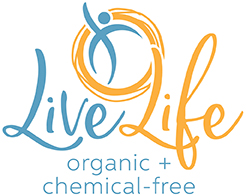
Did you know that even organic clothing can have harmful chemical finishes?
With more than 8,000 chemicals used in the textile industry, is a wonder: how many chemicals are in your clothes?
Incomplete information and clothing tags without all ingredients listed leads to poor buying choices – buying clothing we think is free of harmful chemicals but in actuality is not.
We’ll cover the biggest challenges and 6 ways to find clothes with nontoxic finish.
What’s The Biggest Challenge of Finding Clothes With Nontoxic Finish?
Not all finishes are achieved with toxic chemicals.
For example, “wrinkle-free” can be achieved by spinning thread differently. This makes it difficult to know if wrinkle free means that clothes have a nontoxic finish or a chemical finish.
So, we take it one step further: we read the description.
The same company advertised finishes on two different shirts. One description says “Double ring-spun fabric fights shrinkage, wrinkles, fading and pilling.”
That same company has a women’s shirt marketed simply as “wrinkle resistant.”
Since one description has the ring-spun method and the second description does not, I would suspect shirt number one to have no (or at least less) chemicals as a finish, and shirt number two to have a man-made chemical finish.
Above all, since manufacturers are not required to list ingredients on the labels there is no way for us to know for sure.
Third-Party Certification
While it’s not possible (at this time anyway) for us to know what chemicals are in clothing finishes, it IS possible for others to know. Someone has to know what’s in the shirt finishes… right?
There are a few third-party certification companies that are on our team.
GOTS – Global Organic Textile Standard.
With the strictest standard IN THE WORLD for nontoxic clothing, GOTS leads the way in credible third-party certifications that have people’s health as a priority.
Clothing with a GOTS Organic certification is 95-100% organic or free of harmful chemicals.
They take into consideration clothing:
- material
- dye
- finish
- notions (buttons, zippers, etc)
- design (lettering, graphics)
- tags
- packaging
Equally important, they also evaluate the company’s environmental impact and social parameters (fair trade, wages, work environment).
OEKO-TEX Standard 100.
The second strictest world-wide standard for nontoxic clothing is the Standard 100 by OEKO-TEX.
They consider the following:
- material
- dyes
- finishes
- design (prints)
- notions
- harmful chemicals, even if they’re not regulated by government yet
OEKO-TEX has different standards based on age.
In other words, criteria for toddlers clothing, clothing worn close to the skin (undies, t-shirts, socks) and clothing used away from the skin (jackets, coats) is different.
They also take quality assurance into consideration.
What makes OEKO-TEX Standard 100 less rigorous than GOTS?
GOTS certification:
- Looks for more harmful chemicals than OEKO-TEX does.
- Includes packaging and tags as part of the criteria (think of what a big impact packaging has on the environment!)
- Takes into consideration social and fair trade aspects.
To be clear, OEKO-TEX Standard 100 is still a great certification and tool for us to have when looking for clothes with nontoxic finishes (and nontoxic overall).
Both organizations have access to clothing details (e.g. chemical content, etc) that we do not.
Plus, they are third-party certifying agencies (that use independent testing and certification agencies) which makes their certifications credible.
6 Ways to Find Nontoxic Finishes
1.GOTS Organic Certification. The easiest way is to look for GOTS Organic certification logo or label on clothing tags.
Not the garment tag, but on the removable or packaging tag and online descriptions. Be sure it says “organic” certification. (P.S. If not, it could contain more than 95% chemicals.)
2. OEKO-TEX Standard 100 Certification. Check garment tags, marketing material and online descriptions for this certification label.
While OEKO-TEX has various certifications, the Standard 100 is the most rigorous they offer for clothing.
There is not a stated percentage; therefore, it’s unclear how much of the Standard 100 clothing is organic or chemical-free.
3. Choose labels without “resistant”. Steer clear of “stain resistant,” “water resistant,” and “wrinkle resistant” clothing. These finishes are typically made of harmful chemicals.
4. Look for Made in USA. Additional pesticides and mold inhibitors are often added to clothing that comes to the USA, from overseas. While the Made in USA label isn’t a guarantee of pesticide-free clothing, your chances of fewer pesticides may be better.
5. Ditch the antimicrobial. Washing natural clothing in soap and vinegar can remove odors and bacteria. There is no need for the extra chemicals in antimicrobial clothing in the typical household.
6. Free of flame retardant. Flame retardants are in the process of being phased out in several states. And with good reason. Studies show that flame retardants are not as effective as once though. Plus, they’re harmful to health and the environment.
Final Thoughts
Since manufacturers do not list all ingredients on garments, it’s impossible for us to know without the help of others, if our clothing has a toxic finish.
In fact, this doesn’t just apply to clothing, it applies to the products we buy (and use) every single day.
Want more tips for creating the best organic, chemical free household one step at a time?
